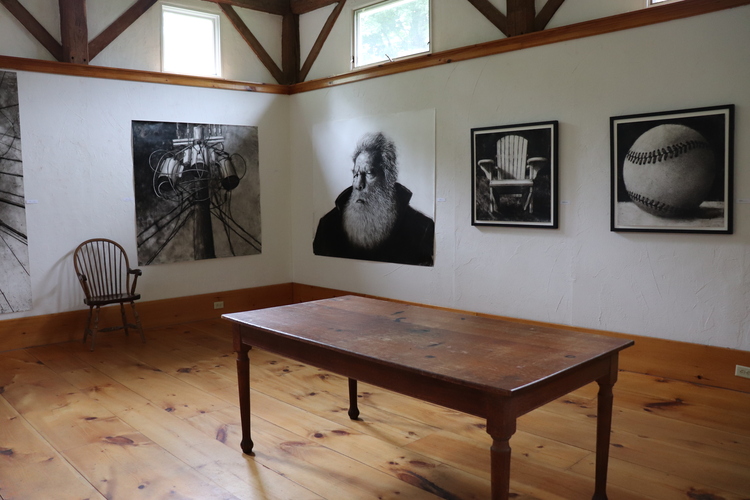NEWFANE — Leonard Ragouzeos's art rivets attention to detail, exposing the essence of his subjects from a graceful kohlrabi plant - "that I grew," he says - to an intricately stitched baseball to a dark-eyed, bearded fellow.
The artist's black ink drawings, on display through Friday, Aug. 31, in the Crowell Gallery at Moore Free Library, employ a technique he's been honing for a few decades.
Using brushes, pens, rollers, and other tools, he applies India ink to Yupo paper - an archival synthetic paper with a smooth, non-absorbent, vellum-like surface.
"My expectation," he puts forth in an artist's statement, "is for the viewer to see and understand the image from afar, but also to be drawn in for closer inspection to view, on a purely abstract level, the surface texture of marks, ink splatters, and drips, allowing the viewer to engage with the process of making."
Along with the human form and face, Ragouzeos is attracted to the complexity of simple subjects: tools, vegetables, and "food, functional things," he says, "everyday things you'd find around the house."
He renders objects in isolation - out of any context - and presents them in uberscale, working in dimensions that range from 1 foot square to supersized.
"I try to take something mundane and put it in a sort of gothic or baroque light," he says.
While Ragouzeos has done many works in color over the years, he is drawn "to the power of the black-and-white image."
"I don't speak the language of color as well as I do black and white, with its high contrasts, subtleties, dramatic values," he says. "I have an eye for that."
And he favors large scale because "it's more fun."
"I like the physicality," he says. "The drawings are made on a wall, so I must move quickly to control the flowing ink [...] to build layers of grays into deep blacks with subtle or dramatic value shifts."
The overbearing power of poles
The Crowell exhibit includes several pieces from Ragouzeos's recent "Poles" series.
"I was doing crows at the time" - one of which can be seen looming over the dining floor in Newfane's Fat Crow eatery. "I heard a crow [on a utility pole], and I took a picture, but the crow had flown away, so I was left with a picture of a pole."
That grabbed him as he dug into what role such poles, usually overlooked, play in our lives "with their overbearing power that we don't even recognize." Who's in control? Who are the senders? the receivers? What do these transmissions and their conduits add to our stress?
He has come to view these poles, with the dynamism in their structure and adornments of wires, cables, and hardware, "as symbols in a long ancient history of tall structures identifying that culture's reigning faith or power," he says.
"From Stonehenge and the cycles of the sun, to pyramids honoring the pharaohs, to the temples and cathedrals of religions and gods and as in today's giant skyscrapers of commerce and capitalism, they represent power," Ragouzeos continues.
From science to art
Ragouzeos was born in Manhattan and raised in the Bronx. His father, an immigrant from Cyprus, worked as a grocer in Astoria, Queens. His mother, whose parents were from Greece, was eager to see their son flourish under America's ideology, and so young Leonard's penchant for art was recognized but not taken seriously.
His parents encouraged him to go to Bronx High School of Science, one of New York's public specialized schools, rather than to the High School of Music and Art in Manhattan, an option that he would have preferred.
It was not until two years into college when his architecture professor urged Ragouzeos to switch to a fine arts focus.
"That's when I began to grow as an artist," he says.
A graphic designer before he became a fine artist, Ragouzeos was influenced in that work by Chuck Close, Jackson Pollock, Jim Dine, and Franz Kline. He cites the work of Sean Scully, Kazimir Malevich, Piet Mondrian, and Brice Marden as influences on his paintings in color.
With bachelor's and master's degrees in fine art earned through the City University of New York system, Ragouzeos is an advocate for public education.
He taught studio art for 31 years at state institutions in Iowa and Pennsylvania.
And, he says in an artist's statement, he "loved every day in which there wasn't a faculty meeting."
'The place to be'
Working out of a studio in Dummerston, Ragouzeos's work is in collections throughout the country from New York to Des Moines to San Diego and has been featured in a host of solo exhibitions at a range of venues nationwide, including at Smith College in Northampton, Massachusetts, and at galleries in Brattleboro and Bennington.
Having first moved to southern Vermont in 2005, Ragouzeos and his wife BobbeKay live bicoastally now, spending five months each year in California, where they have family, and the remaining time in Newfane.
Wrestling a 70-something dilemma of where to alight, he adds, "I like the East Coast, especially Vermont. It seems like the place to be."
The Crowell Gallery, 23 West St., Newfane, is open during the Moore Free Library's operating hours: Tuesday, Wednesday, and Friday, from 1 to 5 p.m.; Thursday, from 1 to 6 p.m.; and Saturday, 10 a.m. to 1 p.m.
This The Arts item by Annie Landenberger was written for The Commons.
